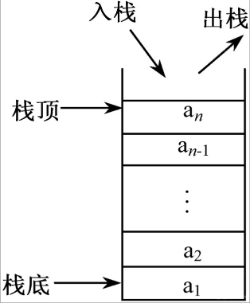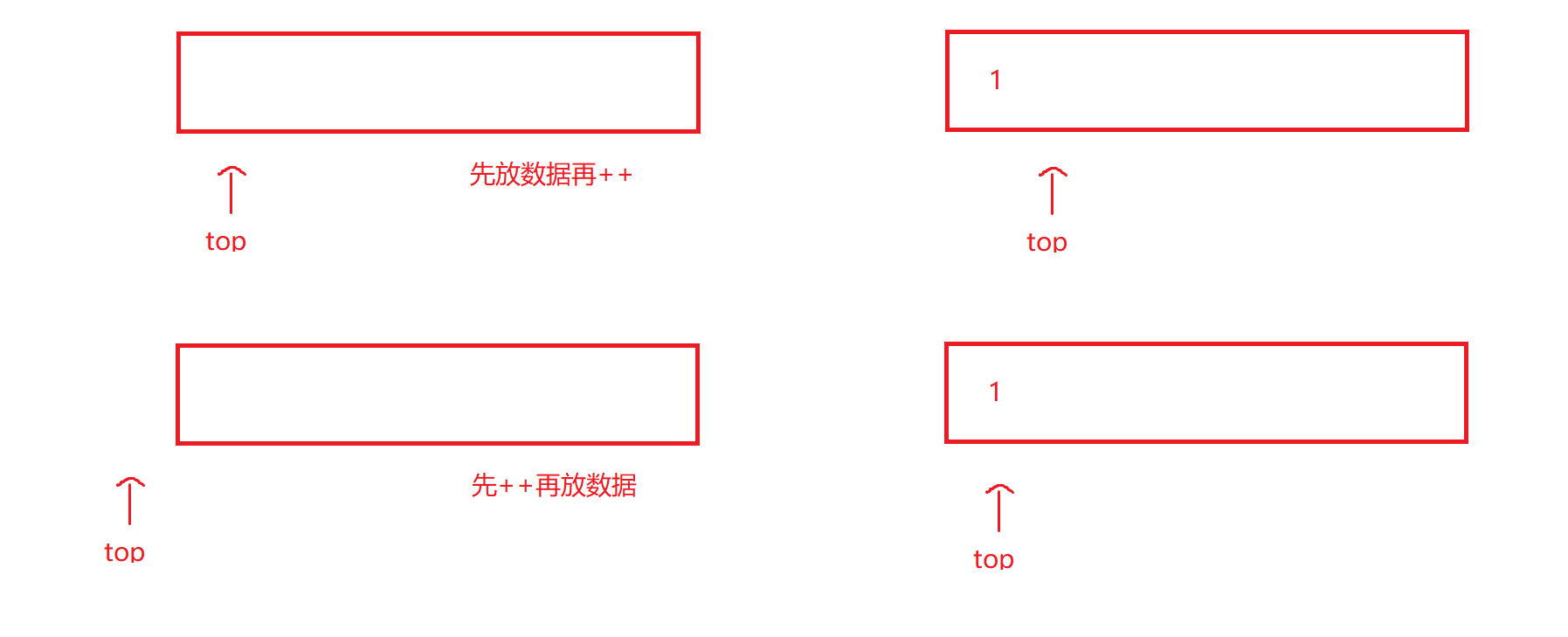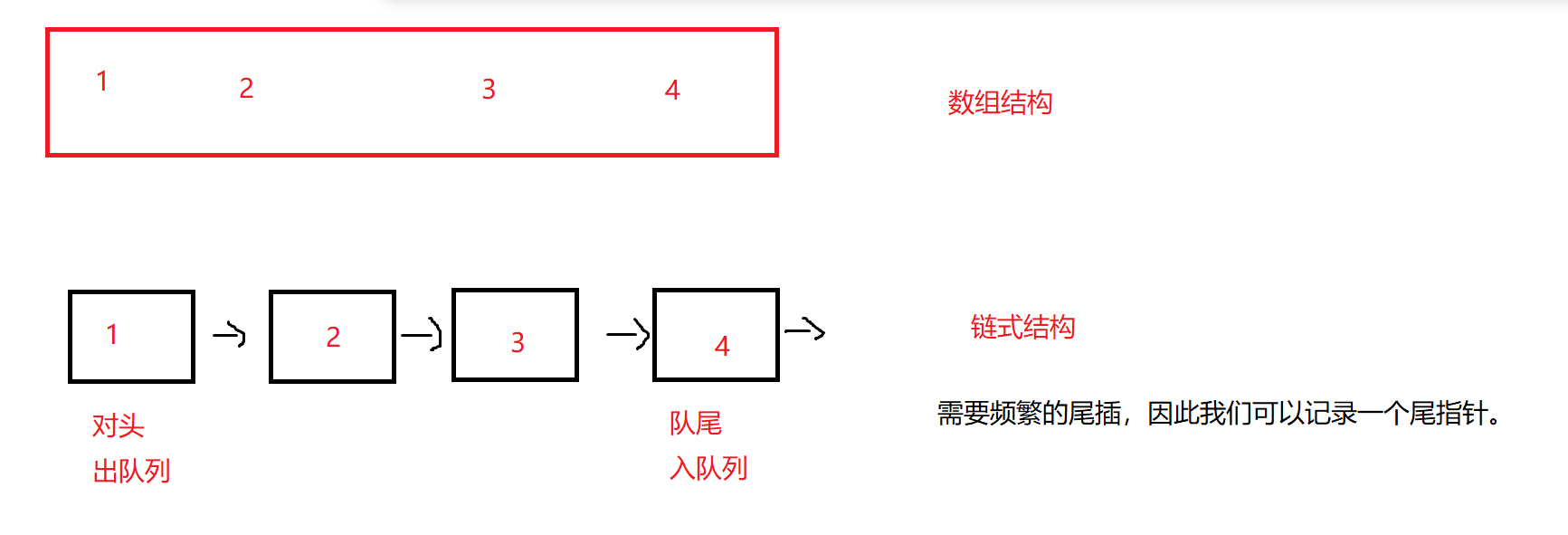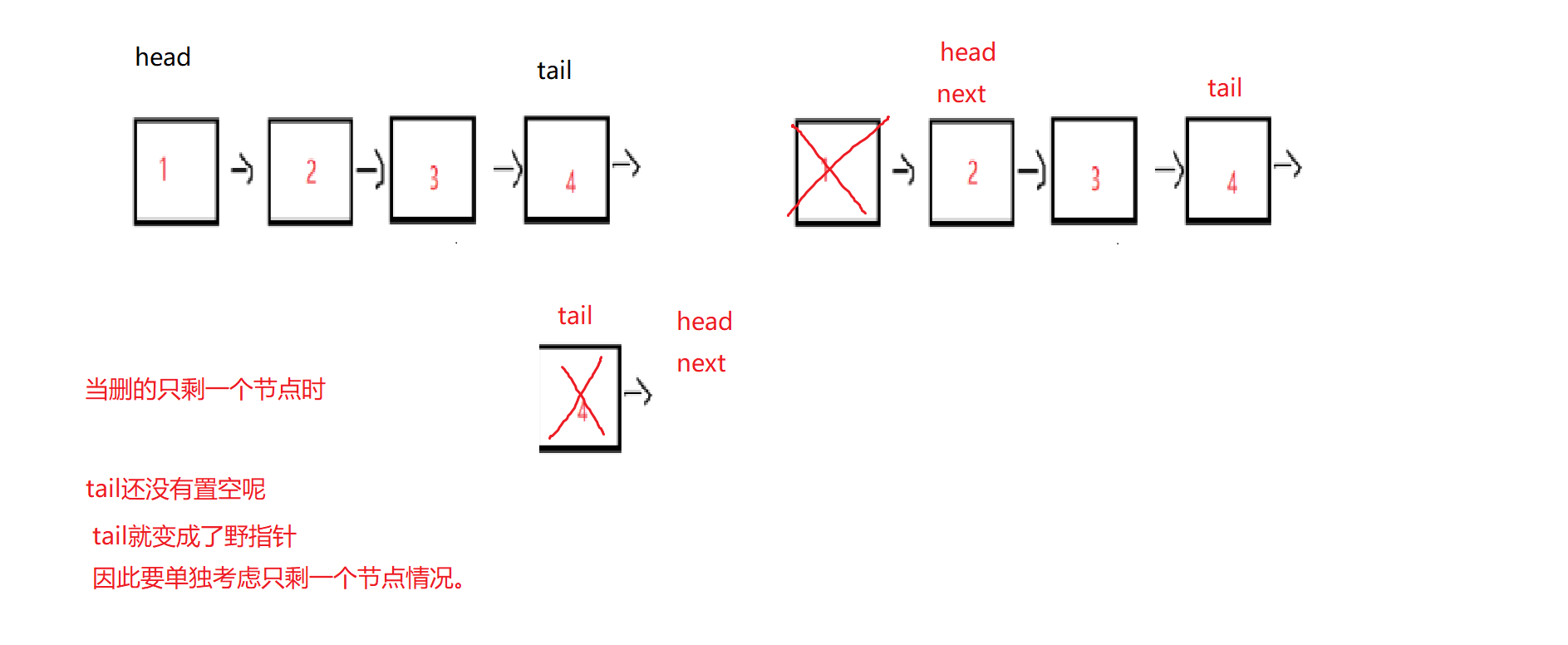0.前言🐕
hello 大家好啊,今天学习的是栈和队列。
🐱🐱🐱
话不多说,直接进入正题。

1.栈🐱
栈(Stack):是只允许在一端进行插入或删除的线性表。栈是一种线性表,但限定这种线性表只能在某一端进行插入和删除操作。
遵循LIFO原则。(Last In First Out)
注意先入后出是相对而言的。
举个例子若进栈序列为 1,2,3,4 ,进栈过程中可以出栈,则下列不可能的一个出栈序列是(C)
A 1,4,3,2
B 2,3,4,1
C 3,1,4,2
D 3,4,2,1
数据插入和删除的一端称为栈顶。
2.栈的实现鬼
实现方式
数组
单链表
单链表去要找尾就不太方便,因此考虑让单链表的头充当栈顶,单链表的尾充当栈底比较方便。
双向带头循环链表
实现栈时比单链表方便,但实现双向带头循环链表实现也麻烦。
综上,使用数组实现更好。
3.栈的代码实现😳
3.1栈的定义
struct Stack
{
STDataType* a;
int top;//栈顶
int capacity;//容量,方便增容
};
3.2初始化&销毁
void StackInit(Stack *pSt)
{
assert(pSt);
pSt->a = NULL;
pSt->capacity = pSt->top = 0;
}
void StackDestroy(Stack *pSt)
{
assert(pSt);
free(pSt->a);
pSt->a = NULL;
pSt->capacity = pSt->top = 0;
}
3.2Push&Pop
考虑清楚top表示的含义
- top初始化为0
top就是当前元素的下一个位置。
需要先放数据再++- top初始化为-1
top指向的就是当前元素。
需要先++再放数据。
// 性质决定了只能在栈顶出入数据
// 选top一开始指向0的方式
void StackPush(Stack *pSt, STDataType x)
{
assert(pSt);
// 满了要扩容,
if (pSt->top == pSt->capacity)
{
int newCapacity = pSt->capacity == 0 ? 4 : pSt->capacity * 2;
// realloc传的新空间的整体大小,如果pSt->a 为空,那么realloc等价于malloc
pSt->a = (STDataType *)realloc(pSt->a, newCapacity * sizeof(STDataType));
if (pSt->a == NULL)
{
printf("realloc fail\n");
exit(-1);
}
pSt->capacity = newCapacity;
}
pSt->a[pSt->top++] = x;
}
void StackPop(Stack *pSt)
{
assert(pSt);
assert(pSt->top > 0); // 有数据才能pop
--pSt->top;
//只需--top即可,无需将要删除元素置0等无谓操作,只要读取不到就认为删除了。
}
注意:
一开始栈为空,newCapacity会被赋值为4,pSt->a 为空,realloc等价于malloc。
void StackPop(Stack *pSt)
{
assert(pSt);
assert(pSt->top > 0); // 有数据才能pop
--pSt->top;
//只需--top即可,无需将要删除元素置0等无谓操作,只要读取不到就认为删除了。
}
3.3判空
bool StackEmpty(Stack *pSt)
{
assert(pSt);
return pSt->top == 0;
}
3.4求大小
由于我们让top是指向元素的下一个位置,因此top的大小恰好就是栈元素的大小。
int StackSize(Stack *pSt)
{
assert(pSt);
return pSt->top;
}
3.5取栈顶元素
// 访问栈顶数据
STDataType StackTop(Stack *pSt)
{
assert(pSt);
assert(pSt->top > 0); // 防止top为0时越界访问
return pSt->a[pSt->top - 1];
}
4.源代码😋
4.1Stack.h
#pragma once
#include <stdio.h>
#include <stdlib.h>
#include <stdbool.h>
#include <assert.h>
typedef int STDataType;
typedef struct Stack
{
STDataType *a;
int top; //栈顶
int capacity; //容量,方便增容
} Stack;
void StackInit(Stack *pSt);
void StackDestroy(Stack *pSt);
// 性质决定了只能在栈顶出入数据
void StackPush(Stack *pSt, STDataType x);
void StackPop(Stack *pSt);
// 访问栈顶数据
STDataType StackTop(Stack *pSt);
bool StackEmpty(Stack *pSt);
int StackSize(Stack *pSt);
4.2Stack.cpp
#include "Stack.h"
void StackInit(Stack *pSt)
{
assert(pSt);
pSt->a = NULL;
pSt->capacity = pSt->top = 0;
}
void StackDestroy(Stack *pSt)
{
assert(pSt);
free(pSt->a);
pSt->a = NULL;
pSt->capacity = pSt->top = 0;
}
// 性质决定了只能在栈顶出入数据
// 选top一开始指向0的方式
void StackPush(Stack *pSt, STDataType x)
{
assert(pSt);
// 满了要扩容,
if (pSt->top == pSt->capacity)
{
int newCapacity = pSt->capacity == 0 ? 4 : pSt->capacity * 2;
// realloc传的新空间的整体大小,如果pSt->a 为空,那么realloc等价于malloc
pSt->a = (STDataType *)realloc(pSt->a, newCapacity * sizeof(STDataType));
if (pSt->a == NULL)
{
printf("realloc fail\n");
exit(-1);
}
pSt->capacity = newCapacity;
}
pSt->a[pSt->top++] = x;
}
void StackPop(Stack *pSt)
{
assert(pSt);
assert(pSt->top > 0); // 有数据才能pop
--pSt->top;
//只需--top即可,无需将要删除元素置0等无谓操作,只要读取不到就认为删除了。
}
// 访问栈顶数据
STDataType StackTop(Stack *pSt)
{
assert(pSt);
assert(pSt->top > 0);
return pSt->a[pSt->top - 1];
}
bool StackEmpty(Stack *pSt)
{
assert(pSt);
return pSt->top == 0;
}
int StackSize(Stack *pSt)
{
assert(pSt);
return pSt->top;
}
4.3Test.cpp
#include "Stack.h"
void Test()
{
Stack st;
StackInit(&st);
StackPush(&st, 1);
StackPush(&st, 2);
StackPush(&st, 3);
StackPush(&st, 4);
// 1 2 3 4 top指向的是4的下一个位置
// 栈是先进后出,不能直接按顺序读取,不然就变成先进先出了。
while (!StackEmpty(&st))
{
printf("%d ", StackTop(&st));
StackPop(&st); //为了访问下一个元素,必须删掉当前的,让top移动
}
StackDestroy(&st);
}
void Test2()
{
Stack st;
StackInit(&st);
StackPush(&st, 1);
StackPush(&st, 2);
// 入了2个就出1个,顺序就变了。
printf("%d ", StackTop(&st));
StackPop(&st); //为了访问下一个元素,必须删掉当前的,让top移动
StackPush(&st, 3);
StackPush(&st, 4);
while (!StackEmpty(&st))
{
printf("%d ", StackTop(&st));
StackPop(&st); //为了访问下一个元素,必须删掉当前的,让top移动
}
StackDestroy(&st);
// 打印结果2 4 3 1
}
int main(int argc, char const *argv[])
{
Test();
system("pause");
return 0;
}
5.队列🦌
队列:只允许在一端进行插入数据操作,在另一端进行删除数据操作的特殊线性表,队列具有先进先出
FIFO(First In First Out)
入队列:进行插入操作的一端称为队尾
出队列:进行删除操作的一端称为队头
入队顺序:A B C D
出队顺序:A B C D
6.队列的实现🍎
我们需要在队尾插入,队头删除。
如果使用数组的结构,出队列在数组头上出数据,需要挪动数据,效率会比较低。
因此用单链表更合适。
单链表的头删是非常高效。
由于需要频繁的尾插,因此我们可以记录一个尾指针。
这里需不需要带上哨兵位呢?可以,但没必要。带上哨兵位了,只是少了一些判空的处理。
7.队列的代码实现😀
7.1队列的定义
前面提到我们要用链表实现队列,而且是要记录一个尾指针来方便尾插。
因此先定义一个链表节点,再定义2个指向节点的指针就是队列啦。
// 定义队列节点
typedef struct QueueNode
{
struct QueueNode *next;
QDataType data;
} QueueNode;
// 定义队列
typedef struct Queue
{
QueueNode *head;
QueueNode *tail;
} Queue;
7.2初始化&销毁
void QueueInit(Queue *pq)
{
// 队列可以为空,但结构体指针不能为空
assert(pq);
pq->head = pq->tail = NULL;
}
销毁也就是把开辟出来的每一个节点都free掉。
void QueueDestroy(Queue *pq)
{
assert(pq);
QueueNode *cur = pq->head;
while (cur)
{
QueueNode *next = cur->next;
free(cur);
cur = next;
}
pq->head = pq->tail = NULL;
}
7.3Push&Pop
Push时注意考虑队列为空的情况。
Pop时要注意考虑删得只剩一个节点的情况,此时tail还没置空。
// 其实就是尾插
// 注意考虑队列为空
void QueuePush(Queue *pq, QDataType x)
{
assert(pq);
// 这里只有push需要创建节点,因此没必要单独写一个创建节点的函数
QueueNode *newNode = (QueueNode *)malloc(sizeof(QueueNode));
assert(newNode); // 暴力检查开辟失败的情况
newNode->data = x;
newNode->next = NULL;
// 考虑队列为空的情况插入
if (pq->tail == NULL)
{
assert(pq->head == NULL); // 保证不可能出现tail为空,head不为空
pq->head = pq->tail = newNode;
}
else
{
pq->tail->next = newNode;
// 注意更新tail
pq->tail = newNode;
}
}
// 其实就是头删,保存好下一个节点
void QueuePop(Queue *pq)
{
assert(pq);
assert(pq->head && pq->tail); // 头尾不能为空
//考虑删到只剩一个节点的情况,尾和头都要置空
if (pq->head->next == NULL)
{
free(pq->head);
pq->head = pq->tail = NULL;
}
else
{
QueueNode *next = pq->head->next;
free(pq->head);
pq->head = next;
}
}
7.4取队头队尾元素
//取队头数据
QDataType QueueFront(Queue *pq)
{
assert(pq);
assert(pq->head); // 保证头也不能为空
return pq->head->data;
}
//取队尾数据
QDataType QueueBack(Queue *pq)
{
assert(pq);
assert(pq->head); // 保证头也不能为空
return pq->tail->data;
}
7.5判空
bool QueueEmpty(Queue *pq)
{
assert(pq);
return pq->head == NULL && pq->tail == NULL;
// return pq->head == NULL; // 只判断一个也行
}
7.6求元素个数
// 队列效率最低的接口就是求size
size_t QueueSize(Queue *pq)
{
assert(pq);
QueueNode *cur = pq->head;
size_t size = 0;
while (cur)
{
++size;
cur = cur->next;
}
return size;
// size每次计算都要遍历一遍链表。
// 如果不想遍历,可以在结构体定义时增加一个size计数,每次插入++size,每次删除--size
}
8.源代码🤭
8.1Queue.h
#pragma once
#include <stdio.h>
#include <stdlib.h>
#include <stdbool.h>
#include <assert.h>
typedef int QDataType;
// 定义队列节点
typedef struct QueueNode
{
struct QueueNode *next;
QDataType data;
} QueueNode;
// 定义队列
typedef struct Queue
{
QueueNode *head;
QueueNode *tail;
} Queue;
// pq表示pointer queue
void QueueInit(Queue *pq);
void QueueDestroy(Queue *pq);
void QueuePush(Queue *pq, QDataType x);
void QueuePop(Queue *pq);
//取队头数据
QDataType QueueFront(Queue *pq);
//取队尾数据
QDataType QueueBack(Queue *pq);
bool QueueEmpty(Queue *pq);
size_t QueueSize(Queue *pq);
8.2Queue.cpp
#include "Queue.h"
void QueueInit(Queue *pq)
{
// 队列可以为空,但结构体指针不能为空
assert(pq);
pq->head = pq->tail = NULL;
}
void QueueDestroy(Queue *pq)
{
assert(pq);
QueueNode *cur = pq->head;
while (cur)
{
QueueNode *next = cur->next;
free(cur);
cur = next;
}
pq->head = pq->tail = NULL;
}
// 其实就是尾插
// 注意考虑队列为空
void QueuePush(Queue *pq, QDataType x)
{
assert(pq);
// 这里只有push需要创建节点,因此没必要单独写一个创建节点的函数
QueueNode *newNode = (QueueNode *)malloc(sizeof(QueueNode));
assert(newNode); // 暴力检查开辟失败的情况
newNode->data = x;
newNode->next = NULL;
// 考虑队列为空的情况插入
if (pq->tail == NULL)
{
assert(pq->head == NULL); // 保证不可能出现tail为空,head不为空
pq->head = pq->tail = newNode;
}
else
{
pq->tail->next = newNode;
// 注意更新tail
pq->tail = newNode;
}
}
// 其实就是头删,保存好下一个节点
void QueuePop(Queue *pq)
{
assert(pq);
assert(pq->head && pq->tail); // 头尾不能为空
//考虑删到只剩一个节点的情况,尾和头都要置空
if (pq->head->next == NULL)
{
free(pq->head);
pq->head = pq->tail = NULL;
}
else
{
QueueNode *next = pq->head->next;
free(pq->head);
pq->head = next;
}
}
bool QueueEmpty(Queue *pq)
{
assert(pq);
return pq->head == NULL && pq->tail == NULL;
// return pq->head == NULL; // 只判断一个也行
}
// 队列效率最低的接口就是求size
size_t QueueSize(Queue *pq)
{
assert(pq);
QueueNode *cur = pq->head;
size_t size = 0;
while (cur)
{
++size;
cur = cur->next;
}
return size;
// size每次计算都要遍历一遍链表。
// 如果不想遍历,可以在结构体定义时增加一个size计数,每次插入++size,每次删除--size
}
//取队头数据
QDataType QueueFront(Queue *pq)
{
assert(pq);
assert(pq->head); // 保证头也不能为空
return pq->head->data;
}
//取队尾数据
QDataType QueueBack(Queue *pq)
{
assert(pq);
assert(pq->head); // 保证头也不能为空
return pq->tail->data;
}
8.3Test.cpp
#include "Queue.h"
void Test1()
{
Queue q;
QueueInit(&q); // 要改变结构体内容,要传结构体指针
QueuePush(&q, 1);
QueuePush(&q, 2);
QueuePush(&q, 3);
QueuePush(&q, 4);
while (!QueueEmpty(&q))
{
//只能出队头
printf("%d ", QueueFront(&q));
QueuePop(&q); // pop掉之后才能取下一个
}
printf("\n");
}
int main(int argc, char const *argv[])
{
Test1();
system("pause");
return 0;
}
9.尾声😁
🌹🌹🌹
写文不易,如果有帮助烦请点个赞~ 👍👍👍
Thanks?(・ω・)ノ🌹🌹🌹
😘😘😘
👀👀由于笔者水平有限,在今后的博文中难免会出现错误之处,本人非常希望您如果发现错误,恳请留言批评斧正,希望和大家一起学习,一起进步ヽ( ̄ω ̄( ̄ω ̄〃)ゝ,期待您的留言评论。
附GitHub仓库链接
附联系方式(2076188013)(QQ)








